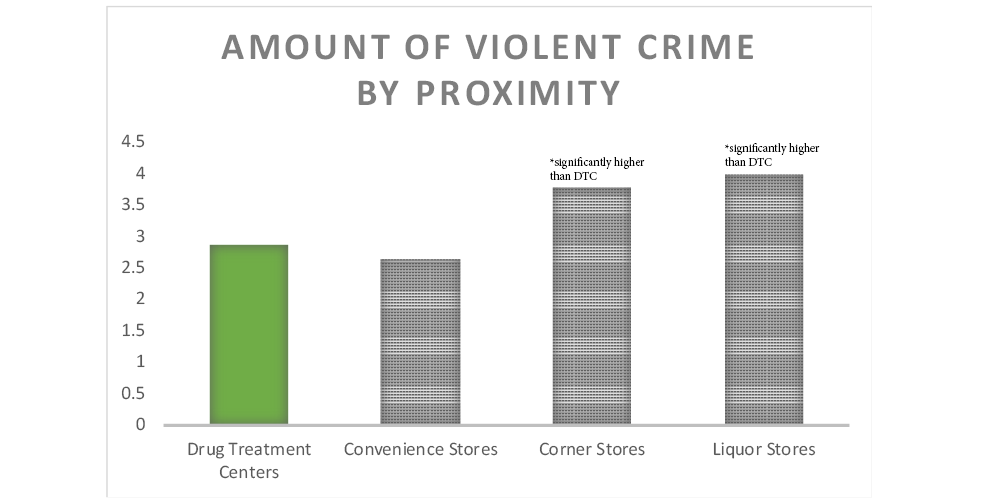Addiction Treatment Centers Don’t Raise Neighborhood Violence Anymore than Convenience Stores
NIMBY (not in my back yard) has been a pervasive attitude that has created resistance to substance use disorder (SUD) treatment centers being built, and barriers in access to care. Researchers in Baltimore, MD tested the claim that publically funded addiction treatment centers were related to violence in excess of other commercial businesses.
They found that violent crime around publically funded addiction treatment centers was no different than around convenience stores, & even less than around liquor stores & “corner” stores.
WHAT PROBLEM DOES THIS STUDY ADDRESS?
The attitude often referred to as NIMBY (not in my back yard) is related to community residents’ resistance to adopt various initiatives in their neighborhood due to concerns about what the initiative will bring, realistic or otherwise. Cite planning has been difficult for substance use disorder (SUD) treatment programs due to local NIMBY (Alcoholism & Drug Abuse Weekly).
This study empirically tested one of the most common NIMBY reasons related to drug treatment centers: increased violence in surrounding area of establishment. Knowledge about the extent of violent crime surrounding drug treatment centers, and if it is the same or different as other commercial establishments with similar hours and foot traffic, can help communities make data driven decisions.
HOW WAS THIS STUDY CONDUCTED?
This study aimed to determine whether publically funded substance use disorder (SUD) treatment centers were associated with violent crime in excess of the violence happening around other commercial businesses. This study analyzed 53 drug treatment programs in Baltimore, MD. Researchers performed a cross-sectional analysis (e.g., where venues were assessed at one point in time) comparing violent crime around SUD treatment centers to violent crime happening around other commercial businesses.
Addresses of all venues were geocoded and mapped. Buffers with varying ranges were placed around each venue to count the density of violent crimes within the buffer. To control for neighborhood disadvantage, the researchers matched drug treatment centers to the convenience, corner, and liquor stores scores on neighborhood disadvantage from the US census.
WHAT DID THIS STUDY FIND?
The average number of violent crimes around addiction treatment centers was significantly less than liquor stores, corner stores, & equivalent to convenience stores.
In addition, there was no difference between drug treatment centers and other stores in the rate that crime declined as you move away from the venue. This implies that drug treatment centers are not ‘magnets’ for crime.

WHY IS THIS STUDY IMPORTANT
Publically funded addiction treatment centers have a reputation as being magnets for crime & a threat to community safety that is not backed by empirical evidence.
This reputation may compound problems associated with stigma related to substance use disorder (SUD) and create unnecessary barriers in access to care (For more on stigma: (Kelly et al. 2015, Kelly et al., 2016).
This timely study helps to dispel myths about violence around treatment centers so communities can make empirically based decisions when considering the benefits of incorporating an substance use disorder (SUD) treatment program into their neighborhood.
- LIMITATIONS
-
- The study did not control for other venue types within each of the buffers around the venue. Therefore, it is possible that an substance use disorder (SUD) treatment center had a liquor store within one of its buffers used to estimate violent crime.
- The sensitivity analysis showed results of a similar direction and magnitude which implies the presence of other venues on estimates of violent crime is minimal.
NEXT STEPS
Future research in this area should incorporate a broad range of community perspectives to balance the empirical data with residential experiences of Not in My Backyard (NIMBY) or otherwise. In addition, more studies are needed in other US cities to determine the generalizability of the results.
BOTTOM LINE
- For individuals & families seeking recovery: If you or your family attend a publically funded substance use disorder (SUD) treatment center, you are not likely to encounter violence in excess of that around a convenience store located within a similar neighborhood.
- For Scientists: Despite attempts at matching venues (e.g., stores and drug treatment centers) on neighborhood disadvantage, there was still some evidence of confounding. Therefore, neighborhood disadvantage must still be considered as an explanatory factor of estimated crime levels.
- For Policy makers: While this study was geographically constrained to one city (Baltimore, MD), and replications are needed to establish generalizability to the larger US, this study shows that constituents concerns about violent crime following the development of a publically funded substance use disorder (SUD) treatment program appear to be unfounded. This study can help mitigate strong opposition to a publically funded SUD treatment program with evidence.
- For Treatment professionals and treatment systems: This study does not speak directly to treatment or recovery processes. However, this study can provide you with evidence to address concerns about any criticisms related to building or moving treatment programs into a new area due to violent crime (e.g., drug treatment facilities are not a “magnet for crime”).
CITATIONS
Furr-Holden, D. C. M., Milam, A. J., Nesoff, E. D., Johnson, R. M., Faukunle, D. O., Jennings, J. M, & Thorpe, R. J. (2016). Not in my back yard: A comparative analysis of crime around publicly funded drug treatment centers, liquor stores, convenience stores, and corner stores in one mid-Atlantic city. Journal of Studies on Alcohol Drugs, 77, 17-24.
